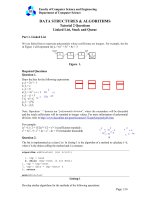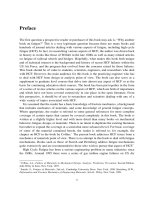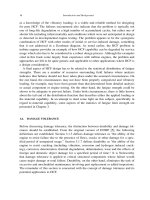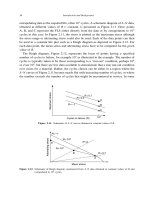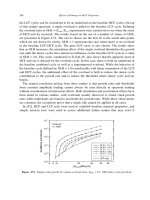Concise Dictionary of Materials Science Part 2 pdf
Bạn đang xem bản rút gọn của tài liệu. Xem và tải ngay bản đầy đủ của tài liệu tại đây (79.04 KB, 4 trang )
tion, at various t, there may be different values of the elasticity modulus,
its extremities being the Young’s modulus E corresponding to the Hooke’s
law at t << τ
R a
nd what is known as the relaxation modulus E
R <
E at t
>> τ
R
. See also internal friction.
anisotropic
Having different physical and mechanical properties in various
directions. Anisotropy of single crystals is a result of crystalline aniso-
tropy, whereas that of a polycrystal is dependent on crystallographic
texture (and so on the crystalline anisotropy) as well as on the microstruc
-
tural anisotropy as, e.g., banded structure or carbide stringers in steels
or an elongated grain structure in heat-resistant alloys (see Nabarro
−
Herring or Coble creep). Anisotropy can be observed not only in crystal
-
line solids but also in some liquids (see liquid crystals).
annealing/anneal
Heat treatment resulting in the occurrence of equilibrium
phases (see, e.g., graphitization anneal, solution annealing), in removing
of deformation or amorphization effects or in attaining a required grain
size or texture (see, e.g., recrystallization annealing), or in relieving chem
-
ical inhomogeneity and macroscopic residual stresses (see homogenizing,
stress-relief annealing). In metallic alloys, annealing is a preliminary
treatment preparing the microstructure or phase composition to a final
treatment (see, e.g., austenitization and solution treatment). Annealing
after amorphization of single-crystalline semiconductors can restore sin
-
gle-crystalline structure.
annealing texture
Preferred orientation evolved in the course of primary recrys-
tallization or grain growth. Recrystallization texture occurs because
recrystallization nuclei are of nonrandom orientations and grow into the
deformed matrix at different rates. It can be similar to deformation texture
or quite different from it. Texture changes during grain growth are con
-
nected with different driving forces for growth of variously oriented grains
and different mobility of their boundaries (see compromise texture). Grain
growth commonly (but not always) results in weakening of the primary
recrystallization texture. Annealing texture is usually characterized by an
increased scatter and a decreased intensity in comparison to the initial
deformation texture, except for a cube texture in some cold-rolled FCC
alloys and the Goss texture in ferritic steels.
annealing twin
Twin occurring during primary recrystallization or grain growth.
Annealing twins are usually observed in materials with low stacking-fault
energy, especially on annealing after heavy plastic deformation. An
annealing twin, depending on its position inside a grain, can have one or
two coherent twin boundaries joining up with grain boundaries or inco
-
herent twin boundaries. The twin with two coherent boundaries looks like
a straight band.
anomalous x-ray transmission
Abnormally low x-ray absorption observed in
thick perfect crystals adjusted at the exact Bragg angle. It is also known
as the Borrmann effect.
antiferromagnetic
Material characterized (below Néel point) by a negative
energy of exchange interaction and equal but oppositely directed magnetic
© 2003 by CRC Press LLC
tion, at various t, there may be different values of the elasticity modulus,
its extremities being the Young’s modulus E corresponding to the Hooke’s
law at t << τ
R a
nd what is known as the relaxation modulus E
R <
E at t
>> τ
R
. See also internal friction.
anisotropic
Having different physical and mechanical properties in various
directions. Anisotropy of single crystals is a result of crystalline aniso-
tropy, whereas that of a polycrystal is dependent on crystallographic
texture (and so on the crystalline anisotropy) as well as on the microstruc
-
tural anisotropy as, e.g., banded structure or carbide stringers in steels
or an elongated grain structure in heat-resistant alloys (see Nabarro
−
Herring or Coble creep). Anisotropy can be observed not only in crystal
-
line solids but also in some liquids (see liquid crystals).
annealing/anneal
Heat treatment resulting in the occurrence of equilibrium
phases (see, e.g., graphitization anneal, solution annealing), in removing
of deformation or amorphization effects or in attaining a required grain
size or texture (see, e.g., recrystallization annealing), or in relieving chem
-
ical inhomogeneity and macroscopic residual stresses (see homogenizing,
stress-relief annealing). In metallic alloys, annealing is a preliminary
treatment preparing the microstructure or phase composition to a final
treatment (see, e.g., austenitization and solution treatment). Annealing
after amorphization of single-crystalline semiconductors can restore sin
-
gle-crystalline structure.
annealing texture
Preferred orientation evolved in the course of primary recrys-
tallization or grain growth. Recrystallization texture occurs because
recrystallization nuclei are of nonrandom orientations and grow into the
deformed matrix at different rates. It can be similar to deformation texture
or quite different from it. Texture changes during grain growth are con
-
nected with different driving forces for growth of variously oriented grains
and different mobility of their boundaries (see compromise texture). Grain
growth commonly (but not always) results in weakening of the primary
recrystallization texture. Annealing texture is usually characterized by an
increased scatter and a decreased intensity in comparison to the initial
deformation texture, except for a cube texture in some cold-rolled FCC
alloys and the Goss texture in ferritic steels.
annealing twin
Twin occurring during primary recrystallization or grain growth.
Annealing twins are usually observed in materials with low stacking-fault
energy, especially on annealing after heavy plastic deformation. An
annealing twin, depending on its position inside a grain, can have one or
two coherent twin boundaries joining up with grain boundaries or inco
-
herent twin boundaries. The twin with two coherent boundaries looks like
a straight band.
anomalous x-ray transmission
Abnormally low x-ray absorption observed in
thick perfect crystals adjusted at the exact Bragg angle. It is also known
as the Borrmann effect.
antiferromagnetic
Material characterized (below Néel point) by a negative
energy of exchange interaction and equal but oppositely directed magnetic
© 2003 by CRC Press LLC
B
β-Al
2
O
3
Impure alumina whose main impurity is Na
2
O.
β eutectoid Ti system
Name of a Ti−X alloy system in which the β-stabilizer
X has a limited solubility in β-Ti, and a eutectoid reaction β ↔ α + γ
takes place (γ is an intermediate phase or a terminal solid solution).
β-Fe
Obsolete designation of the paramagnetic α-Fe existing at temperatures
between 768 and 910°C at atmospheric pressure (i.e., between A
2 a
nd A
3
).
Correspondingly, a solid solution in β-Fe was named β-ferrite.
β isomorphous Ti system
Name of a Ti–X alloy system in which the alloying
element X is the β-stabilizer and there is no eutectoid reaction in the
corresponding phase diagram.
β
m pha
se [in Ti alloys]
See metastable β-phase.
β-phase [in Ti alloys]
Solid solution of alloying elements in β-Ti.
β-stabilizer
Alloying element expanding the β-phase field in phase diagrams of
Ti alloys and thereby lowering β/(α + β) transus.
β-Ti
High-temperature allotropic form of titanium having BCC crystal structure
and existing above 882°C up to the melting point at atmospheric pressure.
β Ti alloy
Alloy with β-stabilizers wherein β-phase is the only phase constituent
after air-cooling from temperatures above the β/(α + β) transus. Alloys
with a small (∼5 vol%) amount of α-phase are related to the same group
and termed near-β alloys. If the β → α transition does not evolve on air-
cooling, these alloys are named metastable β alloys.
background
In x-ray structure analysis and texture analysis, an intensity of scat-
tered x-ray radiation between diffraction lines caused mainly by: x-ray flu
-
orescent radiation emitted by the specimen, diffraction of the white radiation
on the polycrystalline specimen, Compton scattering, and diffuse scattering.
back-reflection Laue method
Technique wherein an x-ray source and a flat
film (screen) registering an x-ray diffraction pattern are placed on the
same side of the sample.
backscattered electron
Electron elastically scattered in the direction that is
opposite to the direction of the primary beam. The yield of backscattered
electrons increases with the atomic number of the substance studied.
Backscattered electrons are used in SEM for gaining data on the topog
-
raphy, microstructure, and chemistry of the specimen surface, as well as
for crystallographic studies (see electron channeling).
0970_frame_B Page 13 Friday, August 1, 2003 7:01 PM
© 2003 by CRC Press LLC
C
χ-carbide
In high-carbon steels, a transient phase of the composition Fe
5
C
2 wi
th
monoclinic lattice. It occurs upon tempering of as-quenched martensite.
CaF
2 st
ructure
Crystal structure wherein Ca
2+ i
ons form an FCC sublattice and
F
1– i
ons, occupying half the tetrahedral sites of the first one, form the
second sublattice (see Figure C.1).
CaF
2
is called fluorite.
calorimetry
Technique for studying phase transitions by measuring thermal
effects, i.e., taking off or releasing the heat in the course of the transitions.
See, e.g., differential scanning calorimetry.
capillary driving force
Driving force for migration of grain or phase bound-
aries under the influence of the boundary curvature (see Gibbs–Thomson
equation); this driving force is directed to the center of the curvature. In
a three-dimensional, single-phase structure, it is:
∆g = γ
gb
(ρ
1
+ ρ
2
)
where γ
gb
is the grain-boundary energy, and ρ
1
and ρ
2
are the principal
radii of the boundary curvature. Capillary driving force promotes normal
and abnormal grain growth, as well as shrinkage of porous compacts in
the course of sintering.
carbide
In binary alloys, an intermediate phase containing carbon. In alloys with
more than two components, metallic components can dissolve in binary
carbides, forming complex carbides.
FIGURE C.1
Unit cell of CaF
2
crystal structure. Solid and open spheres show F
1–
and Ca
2+
ions, respectively.
© 2003 by CRC Press LLC
